Does nature abhor a straight line? Writing about triangles at Througham Court made me think about shapes and the effects that different shapes create. Looking through my photos, I noticed lots of rectangles. Squares appeared, but less often, and usually in formal settings. And then there were circles. They were used frequently in some gardens, not in all in others. I started to wonder why.
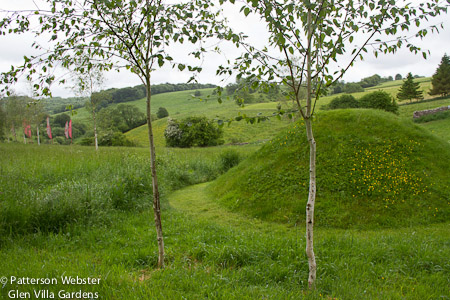 |
| The circular mound at Througham Court |
Traditionally, the circle is a symbol of unity and perfection. Since all points of a circle are equidistant from the center, the circle can symbolize equality. At the same time it can suggest inequality or a hierarchy of value: inner circles are surrounded by outer circles, and the closer to the center, the more important. And, by extension, if a circle suggests inclusion, it also suggests exclusion, since people or objects are either inside or out.
 |
Inner and outer circles of boxwood surround a tree
at The Laskett, the garden of Sir Roy Strong. |
Stone circles appear throughout the British Isles and western Europe: large ones like Stonehenge and smaller ones, like the one below.
 |
| A stone circle on Dartmoor, in Devon, dating back to Neolithic times. |
Circles suggest motion: the repetitive cycles of nature, the turning of a wheel, the never-ending idea of beginning as end. The Japanese see the circle as a sign of strength, elegance and enlightenment. For the Chinese, the circle represents heaven, and the square represents the earth. In every culture I can think of, circles represent celestial objects: the sun, the moon, the earth.
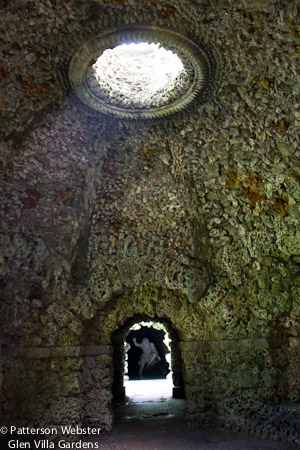 |
| The oculus sheds sunlight in the underground grotto at Stourhead. |
I’ve used circles sparingly at Glen Villa. The most obvious use is in the yin/yang. The circular stone wall that forms its perimeter was built over a hundred years, in the days of Glen Villa Inn. It stood in front of the main entrance to the hotel and provided an easy way for horse-drawn carriages to turn around.
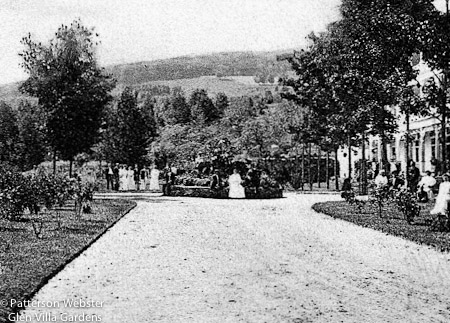 |
| The lady in the white dress is sitting on the edge of the stone wall that became the yin yang. |
When we moved into Glen Villa, the circle was filled with highbush cranberry bushes. They were badly overgrown, out of proportion with the height of the wall so I removed them. But what to plant instead?
Over the winter I sketched out many possibilities. I wanted the garden to illustrate aspects from our family’s history. Since we lived in China in the late 1960s and early 1970s, I decided to use the Chinese yin and yang symbol. It’s a familiar design, most often shown in black and white. In the black area, there’s a spot of white, and in the white a spot of black, to show that everything in nature contains a piece of its opposite.
To emphasize the idea of opposition, I planted the yin yang with contrasting colors and heights. Since the circle had been built for a Victorian-era hotel, I used bedding plants, as the Victorians would have done.
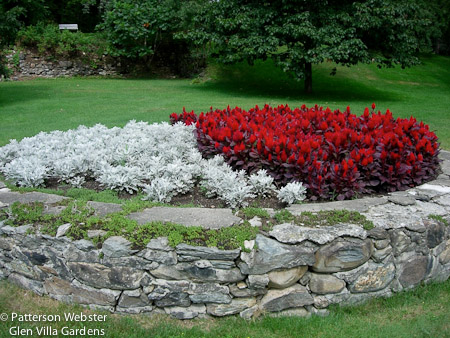 |
| These annuals contrast sharply in colour, height and texture. |
Several years later, I added a new stone coping to the wall. This gave the circle a sleeker, more contemporary look, which called for a different type of planting. I replaced the annuals with festuca glauca and red brick mulch, adding another point of contrast, living and non-living materials.
 |
| I added red brick mulch and festuca glauca to the yin yang, along with a new stone coping. |
In gardens, a planted circle is often the centerpiece of an enclosed space or a pivot point to mark the convergence of several paths. At Glen Villa only one path leads to the circle, an asphalt walkway built so that hotel guests could keep their feet dry as they walked to and from the lake.
 |
| The old asphalt walkway is visible beyond the yin yang. |
Some years ago, I considered creating a maze in this area, but the maintenance it would require convinced me to abandon the idea. Then I saw a different kind of maze, created by Dr. Kathryn Swift at the Dower House, Morville Hall, in Shropshire.
Here, grass cut in higher and lower circles have, over the years, created a labyrinth-like path. Walking the path is meant to focus the mind, to allow a walker to concentrate on the journey more than the destination.
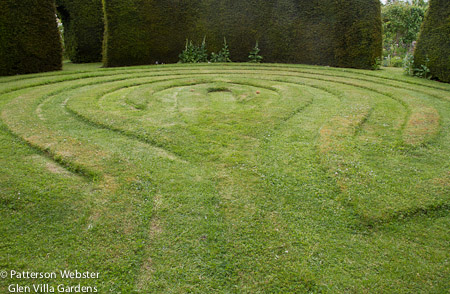 |
| Walking the labyrinth is meant to concentrate the mind. |
I loved this part of Dr. Swift’s garden and immediately began to consider where and how I could reproduce something similar at Glen Villa. There’s a circular space in the woods, ringed with black walnut trees; it would be ideal, but it’s a long way from anywhere. The yin yang would make a good centrepiece, but to be most effective, a labyrinth needs to be set off from the space around it. It needs a hedge or something similar to contain and define the perimeter. And do I really want a hedge to interrupt the flow of the big lawn? Probably not. But maybe a low hedge would be definition enough, so I’ve tucked a note into the (constantly growing) idea file.
There’s another circle at Glen Villa, at the entry to the China Terrace, the garden ‘room’ that recreates, or re-imagines, the old resort hotel.
 |
The circular ‘welcome mat’ at the entry to the China Terrace
reproduces the design that appeared on the hotel’s china. |
It is made of pieces of china from the hotel, broken and altered in colour from the heat of the fire that destroyed the hotel in 1909, laid out like the design on the china. I think of this medallion as a welcome mat announcing where you are and inviting you to enter.
A medallion with a different, and more egocentric, message appears at the entrance to The Laskett, the garden created by Sir Roy Strong and his wife, the late Julia Trevelyan Oman. Sir Roy was head of the Victoria and Albert Museum; Julia Trevelyan Oman was a prominent stage designer.To me, this medallion announces ego more than welcome. The couple’s initials are the centrepiece of the circle, and by implication, the centrepiece of the garden. The message is heightened by the word that encircles the letters: circumspice. Unmistakably it recalls the message on the tomb of Sir Christopher Wren, who built St. Paul’s Cathedral. A black marble plaque on the floor of the crypt is engraved in Latin: Reader, if you seek his monument — look around you. Circumspice.
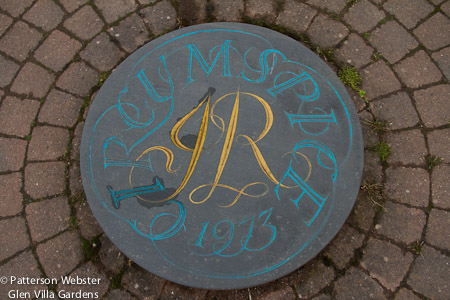 |
| Sir Roy Strong asks us to look around at his garden, his personal monument. |
In the woods at Glen Villa there is another circular space, the sundial clearing that is the end point of the zen-like walk that I titled
In Transit/En Route. (For entries about this art installation, read the three-part series on this: first, second and third blog posts.) Circles play a big role in this installation. An empty circle appears on the signs that lead to the clearing; peering through the empty space focuses the view and concentrates the mind. The circle and square together suggest the Chinese symbolism of heaven and earth. (Although to be accurate, the square should have been inside the circle, rather than the circle inside the square.) And the clearing itself is circular, like the face of a clock, harkening back to neolithic circles that mapped the movement of the spheres. Posts that mark the hours emphasize the movement of the sun – or rather, the movement of the earth around the sun.
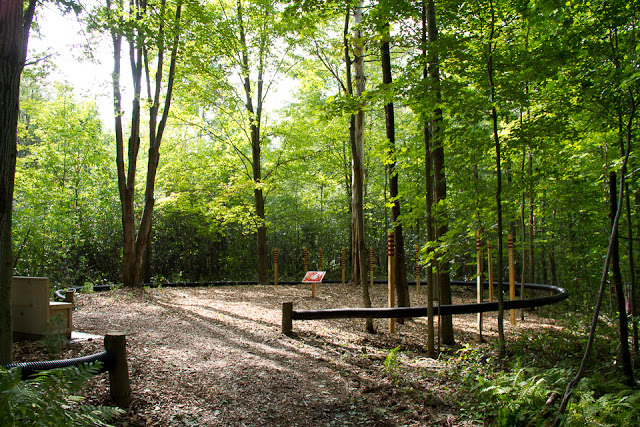 |
The sundial clearing, part of the installation called
In Transit/En Route |
Circles appear at Glen Villa on the floor of the log terrace next to the house. The same slices of wood define the perimeter of The Egg, an oval space with a round egg yolk center. This area was one of the first I developed after we moved into Glen Villa in 1996, and it now is badly in need of a make-over.
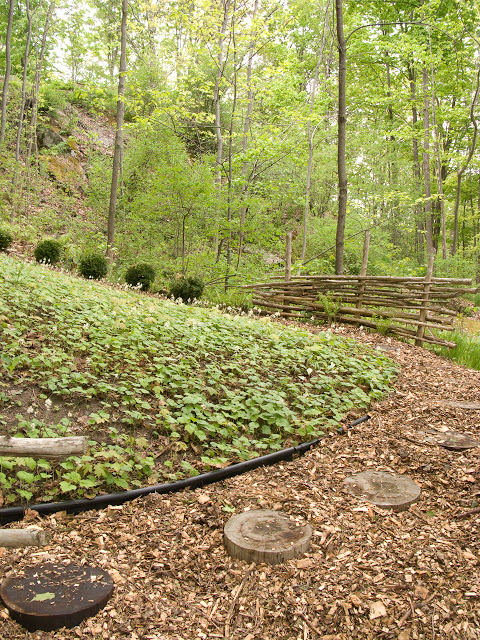 |
Log circles make good steps around the perimeter of The Egg.
Round boxwood also makes an appearance. |
Remaking it is a big project that requires a lot of planning. I’d love to do something as effective as the amphitheatre at Great Fosters, a country hotel just south of London. Of all the circles I saw in England, it was the most impressive by far. The landscape architect Kim Wilkie shaped the land to disguise a major motorway that ruined the view from the hotel. It is a magnificent piece of land art, and its subtle allusions to the past create a magnificent focal point at the end of a long allée.
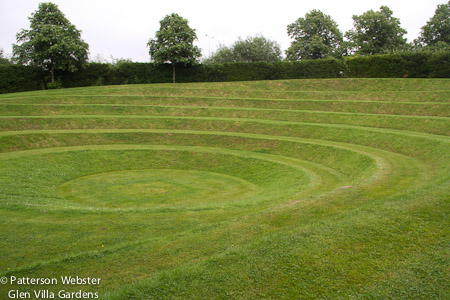 |
Kim Wilkie designed this circular land form to hide the M-40 motorway.
It protects against noise as well as providing a fitting end to the long view from the hotel’s terrace. |
Flowers are a comforting use of circles in a garden. During my recent trip to England, the round head of alliums bobbed in almost every garden. My favourite was the allium that appeared at Bury Court.
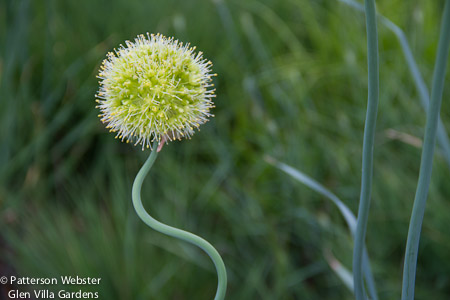 |
The wonderfully curly stem of allium obliquum.
Too bad it’s not hardy in my zone 4 garden. |
I hoped to end this post with some perceptive observations about circles in gardens, but the only conclusion I have reached is subjective. Sometimes I like them, sometimes I don’t. The mound at Througham is only partly successful — it feels arbitrary and too small for the space. The boxwood planted around the tree at The Laskett is a nice idea, but the shrubs are too large, too close together and need to be given room to breathe.
I’ve looked quickly through my photos from many gardens, in England, France, the United States and Canada. Circular fountains, pots, art objects like armillaries and trimmed shrubs occur in some, but the circle as a form is rarely the central design element. Except in this one, from a garden in Charleston, South Carolina, pictured in Gardens of Historic Charleston, by James Cothran.
 |
| A circular garden in Charleston, S.C., designed in 1969 by Loutrel Briggs. |
Here every important element is circular: the small pool and statue ringed by boxwood, the trees whose circular tops we see, the pattern of the bricks in the elevated section behind, and the sundial centred on an open circle that invites you in.
Generally, I’m not a fan of traditional southern gardens but this one enchants me. Despite the formality, I find it inviting. I feel embraced by the design, welcomed as an insider.
How does it make you feel? Do you use circles in your garden? Where, and why?





















